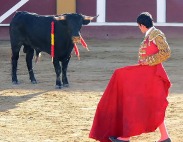
Bullfighting
¡Olé! This is a common cheer that spectators chant to applaud bullfights. To this day, bullfighting remains a popular spectacle in Portugal, Southern France and especially numerous regions in Spain. In fact, nearly 75% of Spanish provinces enjoy bullfighting as millions of citizens and visitors attend a spectacle every year. However, it does have its opposition.
Those in opposition to bullfighting believe it is cruel to sacrifice the bull at the end of the spectacle, while advocates of bullfighting argue it’s an important art form comparable to dancing and music, and it’s a tradition embedded in Spanish culture. It’s important to note that the bull is not always sacrificed at the end of every bullfight. In Portugal the bull is not sacrificed at the culmination of the spectacle and in the Spanish regions of Navarra, La Rioja and in the regions of Castille and Valencia, the bull returns safely to his pen at the conclusion of the performance. So what exactly is the art of bullfighting and where did it originate?
Bullfighting’s Origins
Bullfighting and bull sacrifice originated in Rome. In ancient times, it was common for soldiers to sacrifice a bull as a ritual for good luck. In more modern times, bullfighting became a spectacle in the Roman Coliseum where soldiers or gladiators battled animals. The Roman Emperor Claudius introduced bullfighting to Spain and it quickly became a unique event in Spain.
Roman gladiators and soldiers previously rode horses to compete against the bulls. But in 1726 the Spaniard Francisco Romero remained on his feet and introduced a new style of fighting. Romero – and other bullfighting greats like Juan Belmonte – would remain within a few inches of the bull throughout the event and they used the muleta – a stick that the famous red cape hangs from. Spanish citizens were enchanted with this new style and art form. Thus bullrings were quickly constructed to host bullfights as a popular spectacle.
The Event
The Spanish style of bullfighting is one of the most famous. It’s called corrida de toros or la fiesta and three matadors fight two bulls. It’s a lively spectacle as the matadors dress in colorful gold Analusian clothing, called Toreros. The event is divided into three different stages, and a bugle is blown to announce each stage. However, before the event begins, the matadors parade into the bullring with accompanying music.
Tercio de Varas
In the first stage, called the tercio de varas, the matador waves his cape to observe the bull’s movements and to judge how ferocious or dangerous the bull is. The matador will also poke the bull with his lance to provoke him and wear him down. The matador will then leave the ring after this stage.
Tercio de Banderillas
In the second stage, the tercio de banderillas, the three banderillas attempt to each place two barbed sticks in the bull’s shoulders. This is intended to further weaken the bull for the final performance.
Tercio de Muerte
This is the final stage where the matador re-enters the ring. In one hand he will carry the muleta, the stick with a small red cape on it, and in the other a sword. The matador will get dangerously close to the bull and wave his red cape in front of the bull to urge it to lunge at him. This draws many cheers of “¡ole!” from the crowd and it displays the matador’s control over the bull. The graceful series of three to five passes ends as the matador thrusts his sword between the bull’s shoulder blades. A successful performance is applauded by the crowd when the bull dies instantly to spare it pain.
Overall bullfighting is not as popular as it once was in Spain. However, it’s still celebrated by many as both an art form and a sport that celebrates Spain’s history and its unique culture.
 Follow
Follow


